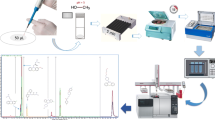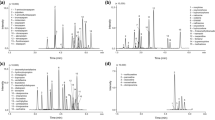Abstract
The present work describes the development and validation of a novel approach to determine methadone (MTD) and its main metabolite (EDDP) in oral fluid samples, using the dried saliva spots (DSS) sampling approach and gas chromatography-tandem mass spectrometry (GC-MS/MS). Oral fluid samples (50 μL) were applied into Whatman™ 903 protein saver filter paper cards and were allowed to dry overnight. The extraction was carried out by immersion of the spot in 1 mL of isopropyl alcohol with agitation for 1 min. Afterwards, the extract was centrifuged for 15 min at 3500 rpm and the supernatant evaporated to dryness and reconstituted with 50 μL of methanol. The procedure was considered linear in the range of 10 to 250 ng/mL for both compounds, with determination coefficients greater than 0.99. Intra- and inter-day precision and accuracy revealed coefficients of variation (CVs) lower than 15% at the studied concentrations, with mean relative errors within ± 15% of the nominal concentrations. Recoveries ranged from 45 to 74%. The limits of detection and quantification were 5 and 10 ng/mL respectively for both analytes. All studied parameters complied with the defined criteria and the method enabled the successful determination of MTD and EDDP in oral fluid samples from patients undergoing opiate substitution/maintenance therapy.




Similar content being viewed by others
References
Ferrari A, Coccia CPR, Bertolini A, Sternieri E. Methadone—metabolism, pharmacokinetics and interactions. Pharmacol Res. 2004;50:551–9. https://doi.org/10.1016/J.PHRS.2004.05.002.
European Monitoring Centre for Drugs and Drug Adiction. European Drug Report 2018: trends and developments. Lisbo; 2018. https://www.emcdda.europa.eu/system/files/publications/8585/20181816_TDAT18001PTN_PDF.pdf. Accessed 3 July 2018.
Armstrong SC, Wynn GH, Sandson NB. Pharmacokinetic drug interactions of synthetic opiate analgesics. Psychosomatics. 2009;50:169–76. https://doi.org/10.1176/appi.psy.50.2.169.
Buchard A, Linnet K, Johansen SS, Munkholm J, Fregerslev M, Morling N. Postmortem blood concentrations of R- and S-enantiomers of methadone and EDDP in drug users: influence of co-medication and P-glycoprotein genotype. J Forensic Sci. 2010;55:457–63. https://doi.org/10.1111/j.1556-4029.2009.01278.x.
Hui Diong S, Shuhadah N, Yusoff M, Sim MS, Elina R, Aziddin R, et al. Quantitation of methadone and metabolite in patients under maintenance treatment. J Anal Toxicol. 2014; 38:660–6.https://doi.org/10.1093/jat/bku096.
Lin H-R, Chen C-L, Huang C-L, Chen S-T, Lua A-C. Simultaneous determination of opiates, methadone, buprenorphine and metabolites in human urine by superficially porous liquid chromatography tandem mass spectrometry. J Chromatogr B. 2013;925:10–5. https://doi.org/10.1016/j.jchromb.2013.02.020.
Larson MEM, Richards TM. Quantification of a methadone metabolite (EDDP) in urine: assessment of compliance. Clin Med Res. 2009;7:134–41. https://doi.org/10.3121/cmr.2009.859.
Meng L, Zhang W, Meng P, Zhu B, Zheng K. Comparison of hollow fiber liquid-phase microextraction and ultrasound-assisted low-density solvent dispersive liquid–liquid microextraction for the determination of drugs of abuse in biological samples by gas chromatography–mass spectrometry. J Chromatogr B. 2015;989:46–53. https://doi.org/10.1016/J.JCHROMB.2015.02.039.
Bogusz MJ, Maier RD, Schiwy-Bochat KH, Kohls U. Applicability of various brands of mixed-phase extraction columns for opiate extraction from blood and serum. J Chromatogr B Biomed Appl. 1996;683:177–88.
Schumacher S, Seitz H. A novel immunoassay for quantitative drug abuse screening in serum. J Immunol Methods. 2016;436:34–40. https://doi.org/10.1016/J.JIM.2016.06.004.
Rodriguez-Rosas ME, Lofwall MR, Strain EC, Siluk D, Wainer IW. Simultaneous determination of buprenorphine, norbuprenorphine and the enantiomers of methadone and its metabolite (EDDP) in human plasma by liquid chromatography/mass spectrometry. J Chromatogr B. 2007;850:538–43. https://doi.org/10.1016/j.jchromb.2006.11.025.
Barroso M, Dias M, Vieira DN, López-Rivadulla M, Queiroz JA. Mixed-mode solid-phase extraction for sample cleanup in hair analysis for methadone and its main metabolite. Biomed Chromatogr. 2010;24:1240–6. https://doi.org/10.1002/bmc.1434.
Gallardo E, Barroso M, Queiroz J. Current technologies and considerations for drug bioanalysis in oral fluid. Bioanalysis. 2009;1:637–67. https://doi.org/10.4155/bio.09.23.
Montesano C, Simeoni MC, Curini R, Sergi M, Lo Sterzo C, Compagnone D. Determination of illicit drugs and metabolites in oral fluid by microextraction on packed sorbent coupled with LC-MS/MS. Anal Bioanal Chem. 2015;407:3647–58. https://doi.org/10.1007/s00216-015-8583-8.
Gallardo E, Queiroz JA. The role of alternative specimens in toxicological analysis. Biomed Chromatogr. 2008;22:795–821. https://doi.org/10.1002/bmc.1009.
Queiroz JA, Gallardo E, Barroso M. What are the recent advances in forensic oral fluid bioanalysis? Bioanalysis. 2013;5:2077–9. https://doi.org/10.4155/bio.13.186.
Gallardo E, Barroso M, Queiroz JA. LC-MS: a powerful tool in workplace drug testing. Drug Test Anal. 2009;1:109–15. https://doi.org/10.1002/dta.26.
Maurer HH. Advances in analytical toxicology: the current role of liquid chromatography-mass spectrometry in drug quantification in blood and oral fluid. Anal Bioanal Chem. 2005;381:110–8. https://doi.org/10.1007/s00216-004-2774-z.
Toennes SW, Kauert GF, Steinmeyer S, Moeller MR. Driving under the influence of drugs - evaluation of analytical data of drugs in oral fluid, serum and urine, and correlation with impairment symptoms. Forensic Sci Int. 2005;152:149–55. https://doi.org/10.1016/j.forsciint.2004.08.002.
Wolff K, Hay A. Methadone in saliva. Clin Chem. 1991;37:1297–8.
Gjerde H, Mordal J, Christophersen AS, Bramness JG, Morland J. Comparison of drug concentrations in blood and oral fluid collected with the intercept sampling device. J Anal Toxicol. 2010;34:204–9.
Suzel Costa de Sousa Escada M. Métodos de análise de piperazinas em fluidos biológicos. Master Thesis. Universidade de Aveiro; 2007. https://docplayer.com.br/77754024-Universidade-de-aveiro-departamento-de-quimicamaria-suzel-costa-de-sousa-e-escada-metodos-de-analise-de-piperazinas-em-fluidos-biologicos.html. Accessed 3 July 2018.
Odoardi S, Anzillotti L, Strano-Rossi S. Simplifying sample pretreatment: application of dried blood spot (DBS) method to blood samples, including postmortem, for UHPLC–MS/MS analysis of drugs of abuse. Forensic Sci Int. 2014;243:61–7. https://doi.org/10.1016/j.forsciint.2014.04.015.
Abdel-Rehim A, Abdel-Rehim M. Dried saliva spot as a sampling technique for saliva samples. Biomed Chromatogr. 2014;28:875–7. https://doi.org/10.1002/bmc.3193.
Numako M, Takayama T, Noge I, Kitagawa Y, Todoroki K, Mizuno H, et al. Dried saliva spot (DSS) as a convenient and reliable sampling for bioanalysis: an application for the diagnosis of diabetes mellitus. Anal Chem. 2016;88:635–9. https://doi.org/10.1021/acs.analchem.5b04059.
Carvalho J, Rosado T, Barroso M, Gallardo E. Determination of antiepileptic drugs using dried saliva spots. J Anal Toxicol. 2018. https://doi.org/10.1093/jat/bky064.
Zheng N, Zeng J, Ji QC, Angeles A, Aubry A-F, Basdeo S, et al. Bioanalysis of dried saliva spot (DSS) samples using detergent-assisted sample extraction with UHPLC-MS/MS detection. Anal Chim Acta. 2016;934:170–9. https://doi.org/10.1016/J.ACA.2016.05.057.
Krone C, Oja A, van de Groep K, Sanders E, Bogaert D, Trzciński K. Dried saliva spots: a robust method for detecting Streptococcus pneumoniae carriage by PCR. Int J Mol Sci. 2016;17:343. https://doi.org/10.3390/ijms17030343.
Irie K, Shobu S, Hiratsuji S, Yamasaki Y, Nanjo S, Kokan C, et al. Development and validation of a method for gefitinib quantification in dried blood spots using liquid chromatography-tandem mass spectrometry: application to finger-prick clinical blood samples of patients with non-small cell lung cancer. J Chromatogr B. 2018;1087–1088:1–5. https://doi.org/10.1016/J.JCHROMB.2018.04.027.
Torres L-M, Rivera-Espinosa L, Chávez-Pacheco JL, Navas CF, Demetrio JA, Alemón-Medina R, et al. A new method to quantify ifosfamide blood levels using dried blood spots and UPLC-MS/MS in paediatric patients with embryonic solid tumours. PLoS One. 2015;10:e0143421. https://doi.org/10.1371/journal.pone.0143421.
Jager NG, Rosing H, Schellens JH, Beijnen JH. Procedures and practices for the validation of bioanalytical methods using dried blood spots: a review. Bioanalysis. 2014. https://doi.org/10.4155/bio.14.185.
Food and Drug Administration. Guidance for industry bioanalytical method validation. 2001. https://www.fda.gov/downloads/drugs/guidances/ucm368107.pdf. Accessed 3 July 2018.
Scientific Working Group for Forensic Toxicology. Scientific working group for forensic toxicology (SWGTOX) standard practices for method validation in forensic toxicology. J Anal Toxicol. 2013;37:452–74. https://doi.org/10.1093/jat/bkt054.
Timmerman P, White S, Globig S, Lüdtke S, Brunet L, Smeraglia J. EBF recommendation on the validation of bioanalytical methods for dried blood spots. Bioanalysis. 2011;3:1567–75. https://doi.org/10.4155/bio.11.132.
Ribani M, Bottoli CBG, Collins CH, Jardim ICSF, Melo LFC. Validação em métodos cromatográficos e eletroforéticos. Quim Nova. 2004;27:771–80. https://doi.org/10.1590/S0100-40422004000500017.
World Anti-Doping Agency. WADA Technical Document – TD2010IDCR Identification criteria for qualitative assays incorporating column chromatography and mass spectrometry. 2010. https://www.wada-ama.org/sites/default/files/resources/files/td2015idcr_-_eng.pdf. Accessed 2 July 2018.
Thompson M, Ellison SLR, Wood R. Harmonized guidelines for single-laboratory (IUPAC Technical Report). Pure Appl Chem. 2002;74:835–55.
Concheiro M, Gray TR, Shakleya DM, Huestis MA. High-throughput simultaneous analysis of buprenorphine, methadone, cocaine, opiates, nicotine, and metabolites in oral fluid by liquid chromatography tandem mass spectrometry. Anal Bioanal Chem. 2010;398:915–24. https://doi.org/10.1007/s00216-010-3903-5.
Hsu YC, Chen BG, Yang SC, Wang YS, Huang SP, Huang MH, et al. Methadone concentrations in blood, plasma, and oral fluid determined by isotope-dilution gas chromatography-mass spectrometry. Anal Bioanal Chem. 2013;405:3921–8. https://doi.org/10.1007/s00216-012-6460-2.
Liu HC, Lee HT, Hsu YC, Huang MH, Liu RH, Chen TJ, et al. Direct injection LC-MS-MS analysis of opiates, methamphetamine, buprenorphine, methadone and their metabolites in oral fluid from substitution therapy patients. J Anal Toxicol. 2015;39:472–80. https://doi.org/10.1093/jat/bkv041.
Kelley M, DeSilva B. Key elements of bioanalytical method validation for macromolecules. AAPS J. 2007;9:E156–63. https://doi.org/10.1208/aapsj0902017.
dos Santos Lucas AC, Bermejo A, Fernández P, Tabernero MJ. Solid-phase microextraction in the determination of methadone in human saliva by gas chromatography-mass spectrometry. J Anal Toxicol. 2000;24:93–6.
Dams R, Murphy CM, Choo RE, Lambert WE, De Leenheer AP, Huestis MA. LC - atmospheric pressure chemical ionization-MS/MS analysis of multiple illicit drugs, methadone, and their metabolites in oral fluid following protein precipitation. Anal Chem. 2003;75:798–804. https://doi.org/10.1021/ac026111t.
Funding
This work is supported by FEDER funds through the POCI-COMPETE 2020 - Operational Programme Competitiveness and Internationalisation in Axis I – Strengthening Research, Technological Development and Innovation (Project POCI-01- 0145-FEDER-007491) and National Funds by FCT – Foundation for Science and Technology (Project UID/Multi /00709/2013).
Author information
Authors and Affiliations
Corresponding author
Ethics declarations
The present study was approved by the ethics committee from Casas de Santiago and has been conducted according to ethical standards. The analyzed samples belonged to individuals who gave an informed consent for their use (including the drug-free samples used in the validation experiments, provided by laboratory staff), and all analyses were carried out according to the ethical standards of the institution.
Conflict of interest
The authors declare that they have no conflicts of interest.
Additional information
Publisher’s note
Springer Nature remains neutral with regard to jurisdictional claims in published maps and institutional affiliations.
Rights and permissions
About this article
Cite this article
Ribeiro, A., Prata, M., Vaz, C. et al. Determination of methadone and EDDP in oral fluid using the dried saliva spots sampling approach and gas chromatography-tandem mass spectrometry. Anal Bioanal Chem 411, 2177–2187 (2019). https://doi.org/10.1007/s00216-019-01654-z
Received:
Revised:
Accepted:
Published:
Issue Date:
DOI: https://doi.org/10.1007/s00216-019-01654-z




